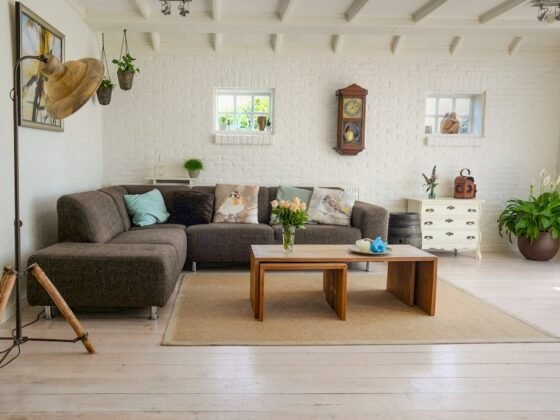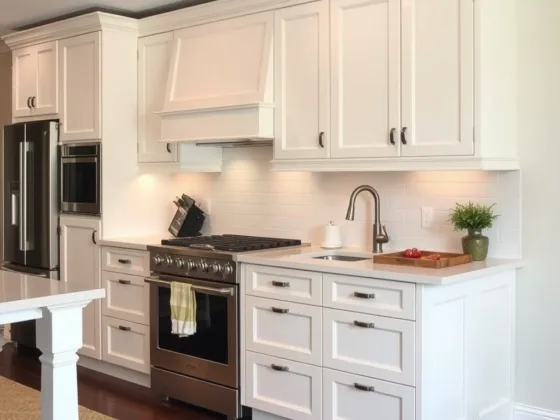Table of Contents Show
Televisions have changed over the years and so have the units that support them. These days, you don’t need to install a heavy piece of furniture to keep your television, as it can easily be mounted on the wall.
However, you can always install sleek, trendy, and beautiful wall units without compromising the available space in your room and keep all the TV consoles there along with some knick-knacks.

This will give your room a classy and contemporary appearance, which is much better than leaving your TV on the wall, all alone.
Most modern TV stands can be mounted on the wall, just like the television itself. You can then design them in your way to enhance the aesthetics of your room.
But before you can do that, you need to know the types of TV stands available in the market to make the best choice.
Let’s help you with that!
Read Also:
- DIY TV Stand Ideas: How to Build a TV Stand Plans, Entertainment Center
- Your Ultimate Guide to Cheapest Internet and Cable Packages
- 7 Budget-Friendly and Chic Ways to Decorate Your Home
- Seven Things Every Studio Apartment for Rent Needs
- Ideas for Decorating around a Flat Screen TV
- Ways to Enhance Your Home’s Curb Appeal
- Bathroom TV: Installation Guide
What Makes an Ideal TV Stand?
Besides aesthetics, you should invest in a TV stand that accommodates all the essential components along with accessories, if any.
For example, you should have some drawers to keep your movie and games collection, a small stand (or a flat panel) to keep your remote, cable box, and organize the wires properly without looking messy.
You should also consider the length of the stand, as it should have enough room to accommodate the television along with its speakers, AV components, DVD player, and more. For example, if you have 75 inch tv stand then definitely should have enough space in the room.
If you have space constraints, the design of the stand should be such that it doesn’t look cluttered and have some shelves to organize everything properly.
Vertical TV stands that can be swiveled to some degrees to offer enhanced viewing experience from every corner of the room are highly recommended.
You can mount an additional flat panel to keep the TV manual, important documents, remotes, and everything else in a neat and de-cluttered manner.
If you wish to keep other things on the stand, like some books, notepads and stationery items, you should opt for a stand that comes with more than one panel.
You can take a look at the list of amazing television stands at https://www.moderndigsfurniture.com/modernfurnitureblog.html?article=Modern-TV-Stand-Guide for a better understanding of what you need.
From classic traditional to contemporary, you can get the idea of what you need to look for here.
It’s unwise to strike-off aesthetics completely, as the television will generally occupy a small space in your living room, where your guests will be entertained.
Consider the material, color, and design of the stand and make sure it matches the interiors to enhance the appearance of the entire room.
You can opt for wood, metal or glass stands, depending on your needs, preferences, as well as the interiors.
Now, let’s give you an idea about the types of TV stands that you can invest in.
Types of TV Stands and the Benefits of Each
While buying a TV stand, you should keep in mind its key purpose, which is to keep your television, speakers, and other necessary equipment in an organized manner.
Modern television units offer proper storage for your DVD collection and games, without taking up much space in the room.
Scroll on to know more about their basic materials, designs, and benefits:
Glass TV Stands
The glass television units are an aesthetic wonder for any sophisticated space.
They not only appear progressive but also enhance the visual appeal of the space by displaying all the electronic units and equipment boldly.
Most of the time, these units are fitted with metal pieces and reflect light, thus making space appear brighter.
If you install a glass TV unit, you need to dust all the equipment regularly to keep them squeaky clean at all times.
Otherwise, they may affect the appearance of the room, as there’s nothing to hide away from the common eye.
The glass units are mainly available as platform stands, which are minimalist in design and don’t come with any sides or walls to provide extra support.
If you want an extensive design, metal or wood may be your best bet.
Metal Stands
The metal TV stands are available in a plethora of styles and designs, are lightweight and hence, more portable than wood.
They can be customized according to your special preferences and size requirements in unique patterns, features, and of course, shades.
You can also opt for a stand that has metal in its basic structure with glass shelves to enhance aesthetics.
The metal stands are best suited for spaces that have classy interiors, like marble flooring and light-colored ceramic walls, a rusty one with grey walls and floors, or anything of a similar appearance.
While choosing the stand, do take a look at its measurements and see if it fits your TV along with its components.
You may not get drawers on the metal stands, but if you do, consider that as your good luck.
Wood TV Stands
The wood television stands are the most common choice for the homeowners, because of their inherent strength, durability as well as appearance.
While metal and glass stands have gained popularity only recently, the wood stands have been there for centuries.
They can be installed both in luxurious, classy homes and contemporary ones, as they are available in diverse styles and designs.
If you have a large space that can accommodate a heavy furniture piece, you can go all-out with your wood TV stand with numerous chambers, shelves, and drawers to keep all essential equipment and accessories.
While the rich, wood texture is most preferred by the homeowners, you can also opt for exquisite patterns and rich tones, depending on your specific choice and the interiors of the room.
Coming to the common styles of TV cabinets, you can consider the following options:
The Entertainment Hub
This unit aims not only to function as a TV stand but a complete entertainment hub for your family by accommodating all the games, AV units, cable boxes, DVDs, speakers, and more.
Generally, they occupy a large space in your living room and become the center of attraction to the onlookers.
Hence, the design and material of the stand should be chosen carefully.
The Cantilever Stand
It’s an amazing, contemporary TV stand that bears the appearance of a wall mount but rests on the floor with a spine rising from the center.
The television is supported by this spine, thus holes are not required to be drilled into the wall, and sits firmly.
The flat panel below the television accommodates all the essential equipment, thus keeping the entire television system well-organized and clutter-free.
The Hideaway Stand
This is best suited for families with children, as they help the parents hide the television away from sight when it’s not being used.
It consists of a motorized TV stand and can be a little more expensive than the other standard units.
However, it’s worth an investment if you have an expensive TV that is susceptible to damages by the children playing in the room.
The Wall Mount
Preferred by most homeowners these days, this is the basic TV stand for the sleek Smart television units of today. They don’t take up any floor space, thus quite suitable for living rooms with limited carpet area.
Holes need to be drilled into the walls to install this stand so that it supports the TV firmly. You should go for this stand only if you’re fairly certain that you won’t need to move the TV some days later.
Wrapping it Up
Buying the right TV stand for your living or any other room can be daunting with so many choices to opt for. You should take the right measurements, consider the aesthetic appeal in your room, and go for the unit that best matches your requirements.
Talk to an expert if you need to but do your homework properly and research on the variety of television stands available in the market before making a purchase.









